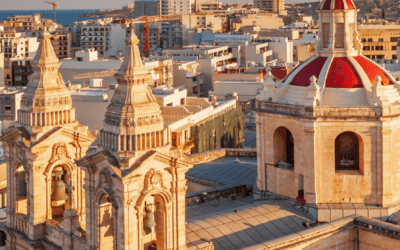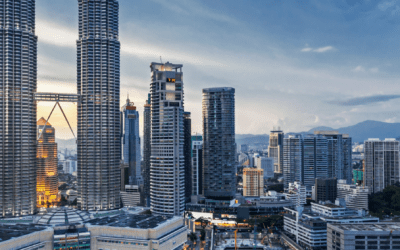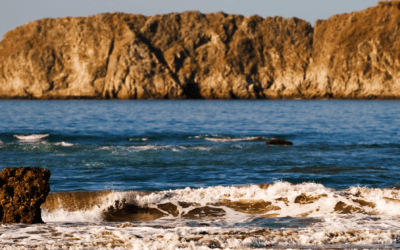Dateline: Istanbul, Turkey
In August, I went back to Amsterdam for the first time since I was eight years old. It’s an interesting city and a nice place to live; plus the people speak English and are generally very nice. I can see the appeal of living there. For me, it ticks all the boxes except for one: it’s not exactly cheap.
Still, it’s worth spending a little more every now and then for the enjoyable nature of the experience. I remember sitting at the top of The W Hotel, having a cocktail, relaxing and having a nice conversation with the bartender. The people are friendly and get your jokes, they have Uber and all the things you’d typically want. Best of all, things just work there.
An extra plus is that Amsterdam is a great location for travelers. You’ve got KLM and an international air transit hub that basically allows you to get anywhere nonstop. It’s easy to get around the world from Amsterdam, both to the Americas — North and South — as well as to Asia, Africa, and the Middle East. You can go pretty much anywhere you want.
If Amsterdam sounds like the perfect location for you, you may want to consider getting residency there. Fortunately for US citizens, the Dutch American Friendship Treaty — or DAFT — allows for Americans who meet certain criteria to obtain Dutch residency. The following are the requirements and basic application process to become a resident of the Netherlands through DAFT:
DAFT Application Process
Step One: Meet the requirements
The Immigration and Naturalization Services (IND) in the Netherlands has outlined several requirements that each applicant must meet in order to qualify for residency. The main condition is that you must operate your business between the US and the Netherlands. Your company must also present a new business opportunity or you must be starting a profession in which you have substantial capital invested.
You will also need to meet the more basic requirements such as having a passport, not presenting a risk to the public or national security, no previous illegal immigration stints in the Netherlands, no false or withheld information on previous applications, and evidence of sufficient and long-term means of support.
Step Two – Scheduling Appointments
In order to proceed, you will need to schedule appointments with both the IND to begin the application process and with the city to obtain your BSN (the Netherlands’ version of a Social Security Number).
If you meet the requirements listed above, you can go ahead and schedule your appointment with the IND. While you can turn in your application without all of the needed documents, you will eventually need to present documents that require you to have a BSN. You cannot get this number without first meeting with the IND, so the process can seem a bit cyclical. However, you can register with the city before your scheduled appointment with the IND and they will just wait until your meeting to assign you a BSN number.
Either way, you will want to schedule both of these appointments as close together as possible since your progress with one depends on the other.
Step Three – Submit your application to the IND
At your first appointment with the IND you will need to present your US passport, the application form, and a cash payment to cover the application fee. They will enter you and your payment into the system and then take your picture, as well as images of your fingerprints and iris.
When you hand in your application to the IND you will be given a temporary visa that will allow you to stay in Netherlands beyond the initial 90 days that US citizens are typically allowed in EU countries. This visa is usually good for six months.
Beyond the form, your application must also include copies of your passport (including pages with travel stamps), an original certificate of the registration of your business with the Dutch Chamber of Commerce (see step five), and a bank statement of your business declaring the amount invested (step seven) along with an opening balance sheet (step eight). Any financial evidence presented in the application must be certified by an external expert (i.e. an accountant or financial advisor).
However, remember that you do not need to present all the requested documents in this initial application since it is impossible to even obtain half the required documents without this first visit and your BSN. This first appointment only initiates the process… which is why there are more steps below.
Step Four – Register with the city to receive your BSN
After meeting with the IND, you will need to present proof of your DAFT residency application in order to register with the municipality and receive your BSN. This proof can be a letter from the IND or the temporary visa sticker in your passport.
You need to register with the city within four months of your arrival in the Netherlands. You will use your BSN for all official forms used in the application process so don’t wait too long to register. At the appointment you will need to present your passport or other ID, proof you’ve applied for the residence permit, a rental agreement or written lodgings agreement and a copy of the owner/main occupant’s identity, and your birth certificate.
Step Five – Register your company
As mentioned, you will need to present your company’s official certificate of registration in your residency application to the IND. To do so, you must register with the KVK — the Netherlands’ Chamber of Commerce.
To register your company as an ‘eenmanszaak’ (sole proprietorship) you will need to present your BSN number, a completed registration form (which can be in Dutch or English), a description of your company in Dutch, and a valid ID.
At the end of your appointment, ask for an official extract of your registration. While there is no registration fee, the official extract will cost you roughly €11. This is the document that you will submit as part of your residency application with the IND.
Step Six – Present a business plan
The best way of showing that you have sufficient and long-term means of support is to submit a business plan as part of your application. This plan also ticks the boxes for showing proof that you are operating a business between the US and the Netherlands or are starting a profession in which you have invested substantial capital. While it is not listed as a required document, this is the best way of proving those specific qualifications and is generally expected from IND officials.
Step Seven – Open a Dutch business bank account
Another application requirement is a bank statement of your business showing the amount invested. Obviously, to get a bank statement you need to open a Dutch bank account. The minimum amount of investment for a self-employed applicant is €4500. Once you have made the deposit, request an official statement from the bank and submit it in your IND application.
Step Eight – Review the opening balance sheet
For most applicants, the opening balance from your business bank account will also function as the opening balance sheet. In the case of more complex businesses, you may need additional documentation showing your assets, liabilities and debt. As mentioned, an external expert such as an accountant or financial advisor will need to review and certify any of these documents.
It is also important to note that in order to renew your residency each year you will need to prove that the minimum required capital has remained in your business bank account throughout the year. Be sure to choose an external expert who will work with you long term so they can verify such information.
Step Nine – Submit documentation and wait
After the initial appointment, you will need to submit the various documents discussed here until all the required documents have been presented and the application is complete. While you can turn in the documents in person, it is also possible to do so by post. As such, it is possible to do certain parts of this residency application while not in the Netherlands.
In fact, the final confirmation of your application and residency status will be by post — not in person. It isn’t official until you’ve received it in the mail, so be sure to watch your mail so you don’t miss anything important.
The challenges of Dutch residency
Now that we’ve covered all the steps, let me tell you what I actually think of getting a second residency in the Netherlands. Most people tend to look at second residencies and passports as if they were all created equally. This couldn’t be further from the truth.
Every residency or citizenship has certain benefits that it can offer, as well as certain inherent challenges. Second residency in the Netherlands is no different.
We’ve already covered the benefits at the beginning of this article, so what are the challenges?
Challenge #1
The first issue is that if you live in the Netherlands full time you’re going to have to pay tax. For some odd reason, people seem to overlook that. To really determine if that’s actually a problem, ask yourself why you’re even interested in Dutch residency in the first place. What’s the goal? To live full time in a country? If so, then it’s not that big of a deal.
However, that’s not what a Nomad Capitalist does. A Nomad Capitalist asks how they can improve their situation, not just go from one frying pan to another. With a second residency in the Netherlands, you won’t have to pay tax in the US, but you’ll be paying taxes in the Netherlands where they’re just the same — and maybe even a little worse — than in the United States.
So how will Dutch residency help your tax situation? It won’t.
If you want to live in the Netherlands, you don’t necessarily need to get a second residency there. You can live there four months a year — two months here and another two there — on a tourist visa. The rest of the year you can find other places you enjoy just as much. For instance, many of the same people who like Amsterdam like Bangkok. Find something that works for you.
Remember that there are many ways to live as a nomad. Consider living in the Netherlands as one of your bases, but don’t make the mistake of thinking you have to become a resident in order to live there — especially if you’re not going to be there full time anyway.
You can spend spring or summer or fall there and then go somewhere warmer for the winter. Live there as a tourist and not only will you avoid being taxed like a Dutch citizen, but you’ll also get tax refunds when you leave. You can get residency in a less tax expensive country.
Challenge #2
The second problem is that you won’t get a second passport from Dutch residency. You can probably get a passport, but the Netherlands does not offer dual citizenship so a second passport isn’t an option.
What’s the point of a residency that does not offer tax benefits or the ability to get a second passport? The chances of ever getting the passport are already low, and if you do get it you’ll just have to renounce any other citizenship you may already have.
So, while I do recommend Europe to some people who are looking for a top tier second passport, I don’t recommend the Netherlands because they don’t have a real program for it. There are, however, a couple of other countries in Europe where you can get a great second passport. Generally, you’ll have to do more work than you would somewhere else (i.e. it’s harder to get an EU passport than it is to get a Serbian, Montenegrin, Albanian or Armenian passport. Those tend to be a little bit easier).
Obviously, the lower on the totem pole the country is, the easier it usually is to get a passport there. However, this rule doesn’t always apply. Bosnia and Herzegovina, for example, makes it almost impossible to get a passport when their travel document isn’t that attractive to begin with. What’s the point of pursuing a passport like that?
Europe, in general, is a great place to visit, but unless you need a powerful second passport then I would skip it for citizenship purposes. Still, if for some reason you need a top tier second passport, there are EU passports you can get that I would recommend over the Netherlands.
Would residency in the Netherlands ever work?
The only situation where I can see a second residency in the Netherlands working is if you’ve got some type of business that absolutely requires you to be in the US, but allows you to move your company to the Netherlands. You’ll be able to hire Dutch workers who offer the same quality of work and speak the same level of English as Americans. I don’t know why your business situation would require this setup, but if for some reason you need to be in that kind of environment and you’re going to pay tax no matter what, then it just might work.
The other part of the situation is that you’d have to be willing to give up US citizenship in the future and just be Dutch. Perhaps this is because you know that you are working on other residencies that will lead to other passports later. This way you can use your Dutch citizenship as a great way to renounce US citizenship, and then later renounce your Dutch citizenship when your other residencies or other citizenship programs pan out.
Quite frankly, it all seems a little convoluted to me. There are much simpler solutions.
For instance, if you have residency in another EU country, you can spend unlimited time in the entire Schengen Area. There are still a few good EU residency programs, including somewhere you can avoid tax. In other words, there’s really no need to get residency or citizenship in the Netherlands to enjoy living there. If you want help finding the right residency program for you, feel free to contact me.









